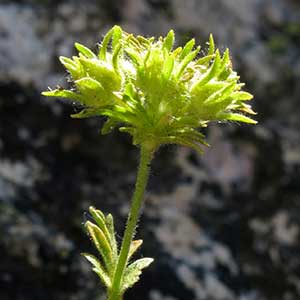Ivesia utahensis
Ivesia longibracteata
Utah ivesia, Utah mousetail
Castle Crags ivesia, longbract mousetail
prostrate to ascending, 0.5–1.5(–2) dm.
ascending to erect, 0.3–1.2 dm.
± tightly cylindric, 2–7(–9) cm; sheathing base glabrous abaxially;
petiole 0.5–2 cm, hairs 0.5–1 mm;
leaflets 15–20 per side, 2–4 mm, glabrate or sparsely short-hirsute, sparsely to densely glandular, lobes (2–)3–8, narrowly oblanceolate to obovate, apex not setose.
weakly planar to loosely ± cylindric, (0.5–)2–4(–6) cm; sheathing base glandular abaxially, otherwise glabrous;
petiole 0.5–2 cm, hairs 0.2–1 mm;
leaflets 5–6 per side, 2–6 mm, ± short-hirsute, glandular-puberulent, lobes 2–7, oblanceolate to spatulate or obovate, apex not setose.
(0–)1, not paired.
1–3, not paired.
(5–)10–30-flowered, 1–2.5(–5) cm diam.;
glomerules 1–few.
3–14-flowered, 1–2.5 cm diam.;
glomerules 1.
1–7 mm.
1.5–6 mm.
7–9 mm diam.;
epicalyx bractlets narrowly oblong to oval, 0.8–2 mm;
hypanthium shallowly cupulate, (1–)1.5–2 × 2.5–3.5 mm;
sepals (1.8–)2–3 mm, acute;
petals white, sometimes pink-tinged, oblanceolate to spatulate, 1.8–3 mm;
stamens 5, filaments 1.3–1.8 mm, anthers orangish to reddish brown, 0.4–0.6 mm;
carpels (1–)2–4, styles 1.5–2 mm.
8–10 mm diam.;
epicalyx bractlets linear to narrowly lanceolate or elliptic, 2.5–5 mm, longer than sepals;
hypanthium shallowly cupulate, 0.5–1 × 2–3 mm;
sepals 1.5–2.5 mm, ± acute;
petals pale yellow, linear to narrowly oblanceolate, 1.5–2.5 mm;
stamens 5, filaments 0.7–1.3 mm, anthers yellow, 0.5–0.8 mm;
carpels 6–11, styles 1–1.5 mm.
yellowish green to light tan or gray-brown, 1.7–1.9 mm.
cream to light tan, 1.2–1.5 mm.
Ivesia utahensis
Ivesia longibracteata
Of conservation concern.
Ivesia utahensis is known from the Wasatch and adjacent Uinta Mountains in northern Utah. The species stands as the white-petaled counterpart to the yellow-petaled Sierran I. lycopodioides, possibly indicating a common ancestral stock that was once more continuous across the Great Basin.
(Discussion copyrighted by Flora of North America; reprinted with permission.)
Of conservation concern.
Ivesia longibracteata is known only from the Castle Crags area of Shasta County. The epithet alludes to a diagnostic characteristic unique in the genus: the epicalyx bractlets are longer than the sepals. The plants grow on vertical rock faces, a habitat more characteristic of sect. Setosae; however, the stems are ascending to erect and do not form hanging clumps, and the pedicels are not curved in fruit.
(Discussion copyrighted by Flora of North America; reprinted with permission.)
